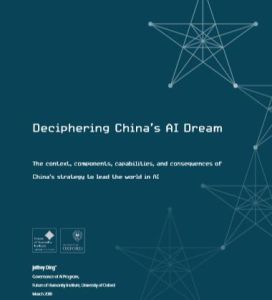Join getAbstract to access the summary!

Join getAbstract to access the summary!
Jeffrey Ding
Deciphering China’s AI Dream
The context, components, capabilities, and consequences of China’s strategy to lead the world in AI
Future of Humanity Institute, 2018
What's inside?
Can China become the world’s leader in artificial intelligence? More to the point, why does it want to?
Recommendation
According to a State Council plan released in July 2017, China intends to lead the world in artificial intelligence (AI). China watchers and technology watchers alike have been asking why, how and whether China can make good on this promise. University of Oxford researcher Jeffrey Ding weighs in with a thorough, insightful report on China’s AI program – its strengths, weaknesses, context and prospects. getAbstract recommends Ding’s comprehensive account to those with an interest in China’s tech future or in the geopolitics of AI.
Summary
About the Author
Jeffrey Ding, a researcher for the Future of Humanity Institute at the University of Oxford, specializes in China’s approach to strategic technologies.
















Comment on this summary